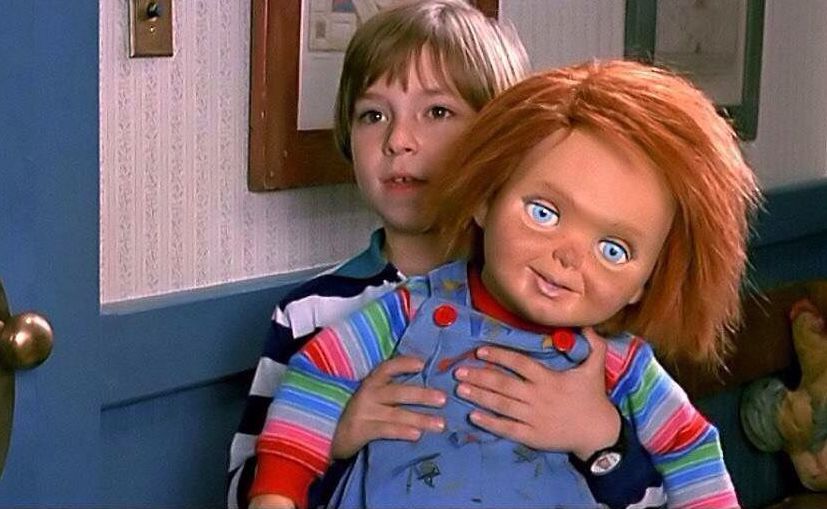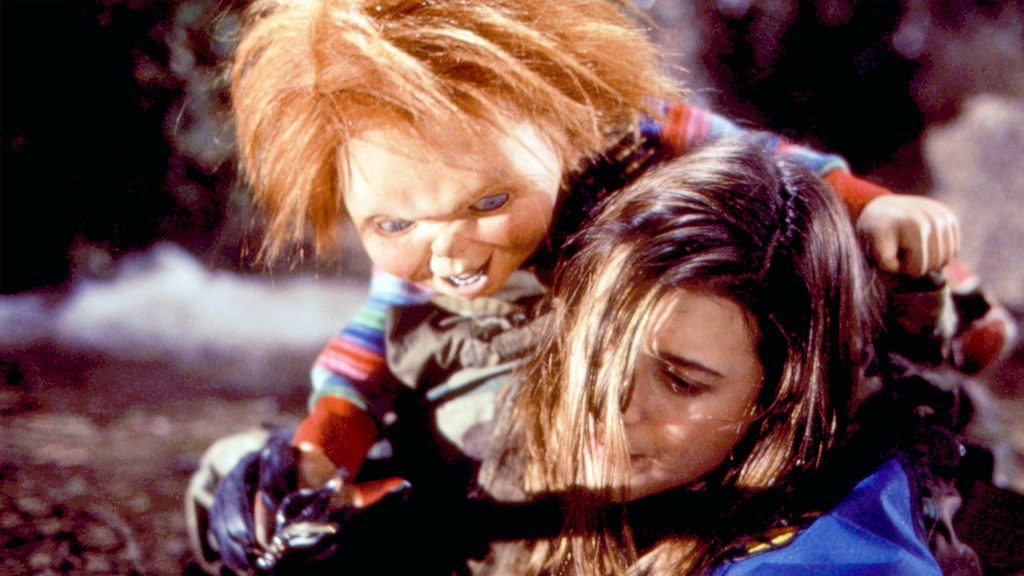By Frank Pittarese
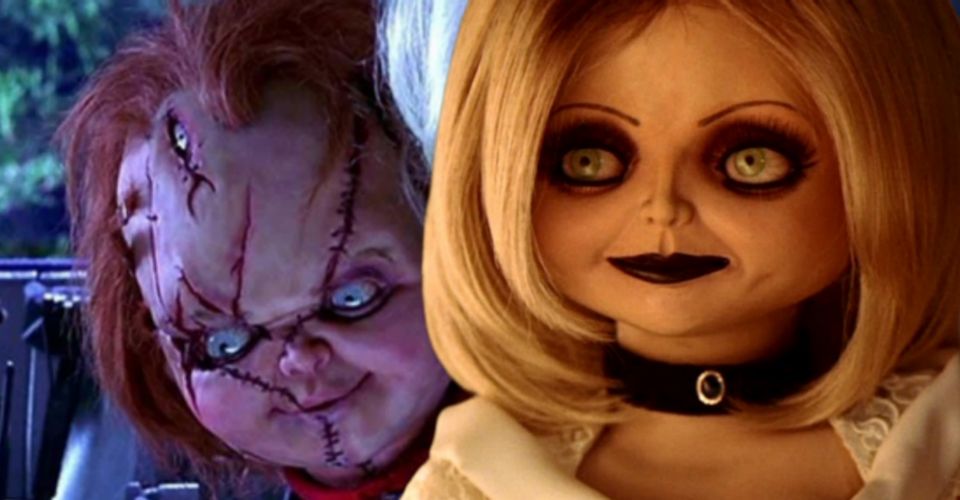
Bride of Chucky (1998) After three movies with the same basic plot, this one takes the series in a (mostly) new direction. Charles Lee Ray’s lunatic girlfriend (played by Jennifer Tilly) gets hold of Chucky’s remains and magically resurrects the little maniac. But when she pisses him off, he kills her and transfers her soul into a bride doll. The plastic pair manipulate and eventually terrorize a couple of runaway teens, with the intention of digging up Charles Lee Ray’s body to retrieve a magical amulet. That amulet, which supposedly would let them transfer their souls into the teens, is a total retcon. It was never mentioned before now, and a crime scene photo here shows Ray wearing it when he died. Nope. Didn’t happen. I checked the footage. But okay, okay…whatever works.
While the body-swap is still central to the plot in a minor way, this really is a breath of fresh air. First off, it’s a lot more comedic than what we’ve seen so far. It owns the fact that the premise is ridiculous, and leans hard into the absurdity of the situation. Tiffany makes an excellent partner for Chucky. He finally has someone to play off of — someone who isn’t a child — and she’s strangely sympathetic, at times. They mayhem is endless, the teens (Katherine Heigl and Nick Stabile) are likable enough, there’s a gay kid who isn’t at all cartoonish, and John Ritter makes an appearance as an overbearing uncle. The kills are clever, but the most over-the-top moments are the sex scene — between the dolls — and the ending, which is a real jaw-dropper. Chucky is back on track. For now. Grade: A-
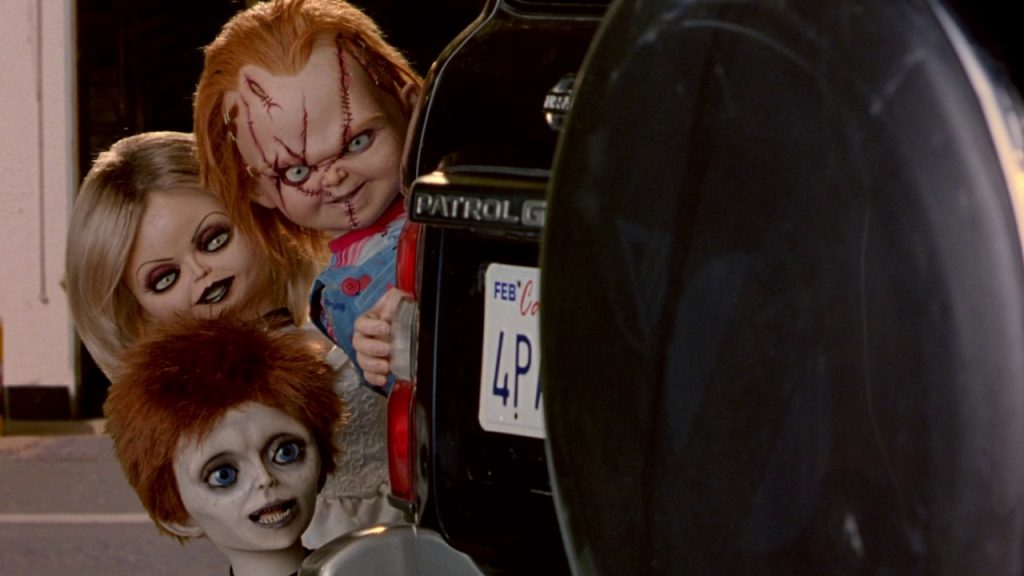
Seed of Chucky (2004) Six years after Tiffany gave birth (yep, that’s what I said), we catch up with the kid, Glen, living a life of captivity in England as part of a ventriloquist act. Meanwhile, Chucky and Tiffany — now just normal dolls — are being used as props in a Hollywood feature film about their murder spree. When Glen sees their parents on TV, they head to America and — using that bullshit amulet invented in the previous movie — restores their evil souls to their doll bodies. And if that’s not complicated enough, the Chuck & Tiff want to use actress Jennifer Tilly (who plays herself in this one, as well as providing the voice of Tiffany) to birth ANOTHER baby, and transfer their souls into the bodies of her and her chauffeur. My head is spinning and I just watched the damn thing.
Any gains made in Bride of Chucky are lost here. The slasher element is still in play, but the comedy is what drives this one, and almost all of it feels tortured (if not straight up vulgar; I could live without seeing Chucky whack off). The body-swap aspect of the series has become exhausting. With Bride, they had the chance to do something else and they alllllmost succeeded, but here we go again.
Glen (sometimes Glenda) is an interesting character, though. The child of Chucky and Tiffany is non-binary, which is pretty progressive in 2004. While they play it for laughs, but only to a degree (and most of the wisecracks come from Chucky), it’s still an interesting choice. But Glen’s design is hideous. They look like the mutant offspring of Chucky and Annabelle. Jennifer Tilly, bless her heart, is really committed to this insanity, and I guess the concept was nutty enough to attract the likes of John Waters, who plays a sleazy photographer. But as much as I want to like this one, it’s a rough ride. Grade: C
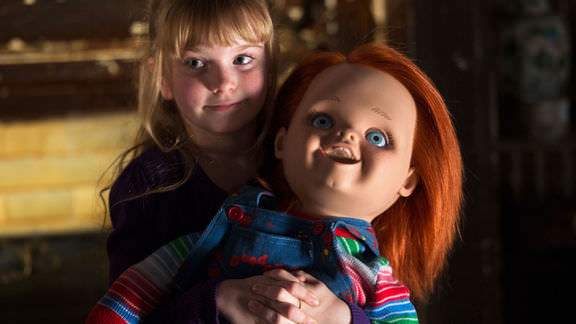
Curse of Chucky (2013) Soon after a Good Guys doll arrives at the Pierce household, the matriarch of the family dies under mysterious circumstances. Chucky circumstances. Nica Pierce (Fiona Dourif, daughter of Brad Dourif — the voice of Chucky), paralyzed since birth, plays host as her sister — with family and nanny in tow — arrives to reminisce and bicker about money. Things seem normal, except for that creepy doll. And why is Charles Lee Ray in the family’s home movies? Let the murders begin!
After the sloppy misstep of Seed, the franchise returns to proper horror-mode. With a gothic vibe and a slower, more deliberate pace, Curse hits all the right notes. Chucky is used minimally for maximum effect, and while he still spouts the occasional wisecrack, this one plays things straight. It’s a huge relief.
One small problem: the unrated cut has a post-credits scene that not only features a major callback to the early films, it literally sets up the next movie in the series. But that version isn’t in the DVD boxed set and it’s not the one streaming on Peacock, so missing that short scene feels like you’ve missed a chapter. It’s a cool bit (which I’m gonna spoil in the next review). Grade: A-
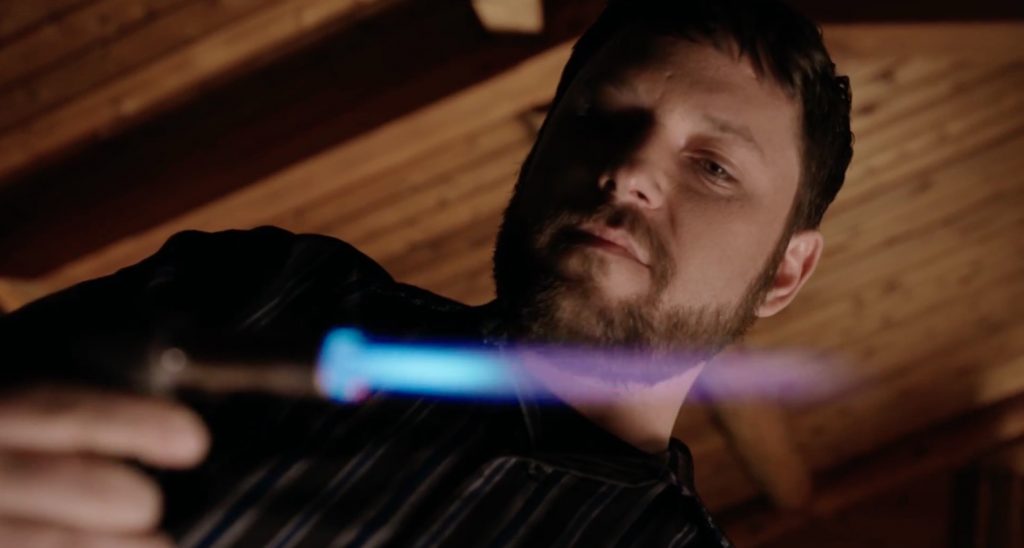
Cult of Chucky (2017) Oof! This franchise is a roller coaster. After the tight creep-fest of Curse, the final entry in the series is a dreary pile of poo. Four years after the last movie, adult Andy Barclay passes the time by torturing Chucky’s severed head. Meanwhile, Nica Pierce is in a mental hospital, having been blamed for her family’s murders. Nica is so screwed up that she even blames herself. Then a Chucky doll arrives at the hospital, courtesy of Jennifer Tilly (still possessed by Tiffany), and a second doll soon follows, along with death and mayhem — all while Andy still seems to have custody of Chucky himself. What’s real? Who’s crazy? Who cares?
This muddled, lethargic mess is a frustrating watch. It’s hard to tell what’s real, and it’s even more difficult to get invested. They seem to be going for a Dream Warriors vibe in featuring a handful of mental patients, but they’re all unpleasant and annoying. Nica is a morose lump. The promise of Andy, which came with the previous film’s post-credits scene (and the opening of this one) feels unfulfilled, as he’s reduced to a subplot until the final act. Answers do come, and the multiple Chuckys (the titular “cult”) are explained (in an offhand way), but by that point, things are completely off the rails and still confusing. The ending sets up another chapter, and is legitimately intriguing…but this one could have been a thousand times better. Hopefully, the TV series will get things back on course. When this franchise is good, it’s great, but when it’s bad, it’s a disaster. This one is bad.
BTW, this sequel also features a post-credits scene which also only exists in the unrated cut — which also features another returning character. The bottom line is: Always go with the unrated cut. With everything. Grade: D-
Make sure you read Part 1 if you missed it!


